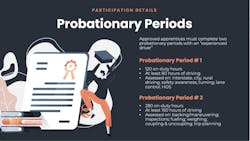Depending on whom you ask, putting younger drivers behind the wheel of Class 8 on-highway trucks can be good for business, help ease supply chain constraints, and appeal to a younger generation of industry talent. Others maintain that allowing 18- to 20-year-old drivers to operate across state lines is far too dangerous.
A new Safe Driver Apprenticeship Pilot Program from the Federal Motor Carrier Safety Administration (FMCSA) will investigate further. The program aims to open the door for 18- to 20-year-old CDL holders to operate in interstate commerce, which is prohibited under current regulations. The agency will gather data from those younger drivers and analyze whether they were in fact involved in more crashes and safety events over the course of the pilot program.
See also: Debate continues for under-21 program
The program hasn't started, but Brandon Wiseman, transportation attorney and owner and president of Trucksafe Consulting, anticipates FMCSA will begin accepting applications in the next couple of months. During a Feb. 1 Next Generation in Trucking Association and DriverReach webinar, Wiseman, along with Dave Harrison, FASTPORT executive director, broke down the nitty-gritty of the program.
A joint effort between FMCSA and the U.S. Department of Labor, the Infrastructure Investment and Jobs Act requires FMCSA to establish a pilot program that would allow employers to establish an apprenticeship program for certain 18-, 19-, and 20-year-old drivers to operate commercial vehicles in interstate commerce. Congress has limited participants to 3,000 apprentices and 1,000 carriers.
“FMCSA has acknowledged that there is quite a bit of turnover in this industry,” Wiseman said. “Even if they eventually approve 3,000 drivers, that will drop as those drivers turn over. The agency is going to have a rolling approval process so when drivers come and go from the industry, they will try to keep that pilot at 3,000."
Though the program is geared toward studying those younger drivers, it all really starts with the motor carriers, Wiseman explained.
He provided a breakdown of what carriers need to be approved:
- FMCSA is prioritizing carriers based on their safety performance over time and accepting only those with the highest or best relative performance.
- Carriers must have a valid U.S. Department of Transportation operating authority or U.S. DOT number.
- FMCSA will not accept moderate or high-risk carriers, meaning those flagged for CSA scores, out-of-service (OOS) rates, and other violations.
- Carriers can’t have open enforcement cases, such as outstanding civil penalties or OOS orders.
- Crash and vehicle/driver OOS rates must be below the respective national averages.
“If [FMCSA gets] 3,000 carrier applicants and they have to whittle it down to 1,000, they are going to pick the carriers with the best safety scores and out-of-service rates,” Wiseman said. “That’s something to keep in mind.”
Apprentices and the approval process
Driver apprentices must be 18 to 20 years old and must have a valid CDL to participate in this pilot program. In addition, they can’t have disqualifying offenses such as having a license suspended, having a conviction for a violation of a traffic law other than parking, having a DUI conviction, failing to take a drug or alcohol test when one is required, leaving the scene of a crash, using a vehicle to commit a felony, etc.
Driver apprentices also must be employed by an approved carrier, Wiseman advised.
To kick off its approval process, FMCSA will eventually publish an application for carriers to complete and file with the agency. Approved carriers then must have their apprenticeship program approved through the Labor Department, Wiseman noted. Only then can carriers present the driver apprentices they want to be approved by FMCSA. The agency will look at their driving records to make sure that they meet the minimum requirements before approving participants, Wiseman added.
Once an apprentice is approved, FMCSA has established two probationary periods that apprentices will progress through over time. The first period calls for 120 on-duty hours, 80 hours of which the apprentice must be driving the commercial motor vehicle.
Once the apprentice progresses, they can move into the second probationary period—280 on-duty hours, 160 of which must be driving hours.During both probationary periods, all apprentices must have an experienced driver present. Experienced drivers must be at least 26 years old, hold a valid CDL, and have held that CDL for at least two years prior to when they are doing the evaluation and must have at least five years of interstate CMV operating experience.
During the webinar, Harrison, who also serves on the White House driver shortage and supply chain task force, pointed to the previous under-21 pilot program for military veterans, in which many of the same standards apply.
“We’ve had drivers under 21 operating in states like Texas and California for a number of years,” Harrison said, noting that advancements of collision avoidance systems and safety technologies have led to significant drops in safety issues and crashes. “If there is a time to do this, it’s now. We have to find new populations to bring in and we have to start engaging at an earlier age or we are all going to be in trouble in this industry going forward.”
Harrison went on to bust an apprenticeship myth that he hears often—the idea that carriers can’t afford to implement an apprenticeship program or training.
“This is simple,” Harrison said. “If you’re training people now, you have an apprenticeship program. You just haven’t formalized it. This should never cost you more than what you are willing to spend to meet your workforce demands.”
Harrison also urged fleet managers to monitor the status of their apprentices and keep updated training records.
“If you’re not, you’re just opening yourself up to a whole bunch of liabilities later,” he noted.
Reporting requirements, best practices
For carriers to participate in the program, they must agree to reporting requirements as a condition for inclusion. Approved carriers will be required to file both monthly and immediate reports with the FMCSA.
According to Wiseman, monthly reports will likely cover apprentice driving activities, such as the number of hours that apprentices have logged, the number of vehicle miles traveled, the number of duty hours and driving hours, safety events, violations incurred by apprentices, and rest breaks taken.
“We don’t have the exact information that the FMCSA will require, but the agency has hinted that this will be the type of information that will be reported on a monthly basis,” Wiseman advised.
Immediate reports are required in the event of crashes with injuries or fatalities, any DUIs, an apprentice leaving the program, and failed drug and alcohol tests.
Another component of the program is that carriers must equip their vehicles operated by apprentices with the following safety technologies: automated manual transmissions, active braking collision mitigation systems, forward-facing cameras, and a governed speed of 65 mph.
Wiseman advised that carriers should also implement their own set of policies and procedures that govern the program, as they will have heightened exposure to highway accidents.
“You are going to want to have a program that is defensible if one of these apprentices gets involved in a catastrophic accident,” Wiseman said.
“In my opinion, it’s not enough that you just follow the rules,” he added. “You need to have parameters around your program, including things like the proper reporting forms, experienced driver qualification records, in-cab documents so if vehicles get pulled over, drivers can turn those over to law enforcement and explain exactly what is going on. FMCSA will get approved drivers an exemption and a copy should be kept in the cab of the truck, but it would also be wise to have an explainer document [for law enforcement].”
Wiseman also urged carriers to build thorough driver training into their policies, and work closely with their insurance providers.





